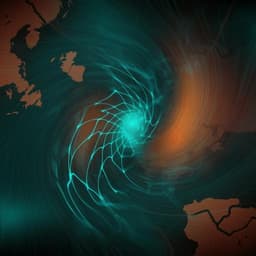
Earth Sciences
Spatial and temporal expansion of global wildland fire activity in response to climate change
M. Senande-rivera, D. Insua-costa, et al.
This groundbreaking study by Martín Senande-Rivera, Damián Insua-Costa, and Gonzalo Miguez-Macho reveals how climate change will reshape fire-prone regions globally. With a staggering 29% increase in areas susceptible to wildfires, particularly in Boreal and Temperate zones, the researchers highlight the urgent need to understand the longer fire seasons driven by a warming planet.
~3 min • Beginner • English
Introduction
Wildfire patterns arise from interactions of climate, fuel availability, ignition agents, and human factors, while fires themselves influence climate via aerosols and greenhouse gases and reshape ecosystems. Although at regional scales human factors can dominate, multiple studies indicate that on broad spatial and temporal scales climate-related factors—particularly fuel availability (often proxied by net primary production) and precipitation—are the main controls of global fire activity. Anticipated climate change is expected to shift the distribution and severity of fire seasons, with studies suggesting increased wildfire potential and a move toward temperature-dominated regimes by century’s end, yet uncertainties remain about magnitude and location of change. This study aims to (1) demonstrate that simple climate indicators can reproduce and explain current global patterns of fire-prone regions and their fire seasons, and (2) use trends in these indicators to infer future changes in the extent and seasonality of fire activity under climate change. The underlying hypothesis is that at broad spatial and decadal scales, observed fire occurrence has high probability where favorable climatic fire settings exist.
Literature Review
The paper synthesizes prior work showing climate outweighs human activities in controlling global biomass burning over the Holocene and across scales, with net primary production and precipitation as key drivers. Past analyses of interannual variability have linked burned area to climate variables, and modeling studies project increased fire season severity and wildfire potential under warming, with potential transition to temperature-dominated fire regimes. However, spatial patterns and magnitudes of change are debated, and human activities can dominate regionally. The study builds on the Köppen–Geiger climate framework and prior global pyrogeographic analyses, situating its classification within existing findings on savanna seasonality, boreal temperature sensitivity, Mediterranean drought-fire links, and ENSO influences on tropical fire variability.
Methodology
Data and periods: Burned area from GFED4 at 0.25° monthly resolution for 1995–2016 (analysis focused on 1996–2016). Climate from WFDE5 (bias-corrected ERA5) for monthly temperature and precipitation, downscaled to 0.25°. Future climate from 22 CMIP5 GCMs under RCP8.5, analyzing present (1996–2016) and future (2070–2099). Future climatology derived with the anomaly method: add temperature anomalies and multiply precipitation by projected ratios, after bilinear interpolation to 0.25°.
Classification framework: Starting from Köppen–Geiger main categories (Tropical, Arid, Temperate, Boreal), the authors define four fire-climate classes using climate thresholds that characterize the fire season: Tropical dry-season (Tr-ds), Arid fuel-limited (Ar-fl), Temperate dry-hot season (Te-dhs), and Boreal hot-season (Bo-hs). Thresholds are determined by contrasting distributions of climate variables at fire-impacted grid-cell years (annual BA ≥ 100 ha) versus non-fire years (BA < 100 ha) within each main climate zone. Variables considered include annual precipitation (Pa), mean annual precipitation (MAP), minimum monthly precipitation (Pmin), monthly precipitation (Pm), mean annual temperature (MAT), monthly temperature (Tm), maximum monthly mean temperature (Tmax), and coldest-month temperature (Tcold), along with a precipitation threshold function (Pthreshold) and distance to wettest month (dmpmax).
Threshold selection: For each Köppen–Geiger zone, density functions of climate variables for fire vs. non-fire points are compared for annual, seasonal (FS months vs. non-FS months), and interannual contrasts during identified fire-season (FS) months. Thresholds are automatically chosen to maximize the area between distributions, with Pmin and Pm as upper limits (seeking dry conditions) and other variables as lower limits (seeking warm/fuel-available conditions). Final thresholds are rounded within uncertainty ranges. Cropland-dominated pixels (>90% cropland burned area) are excluded from threshold derivation due to human-driven seasonality.
Definitions: A grid cell is fire-prone if at least one month meets all class-specific conditions during the period. Fire-prone years (FPY) are years with at least one month meeting all thresholds. Potential fire season (PFS) comprises months meeting thresholds within FPY. Potential fire season length (PFSL) is the average number of fire-prone months during FPY. Classes are subdivided by recurrence: recurrent (r, FPY > 7 years/decade), occasional (o, 3 < FPY < 7), infrequent (i, 0 < FPY < 3).
Future projection approach: Apply present-day class-specific thresholds to future climatology while holding the general Köppen–Geiger climate zones fixed (assuming incomplete vegetation adaptation by 2070–2099). Ensemble confidence is quantified as the percentage of GCMs agreeing on classification at each grid cell. Analyses include changes in spatial extent of classes, FPY, and PFSL.
Key Findings
Validation of present classification: The climate-based fire-prone classes explain most observed burned area. • 99.26% of global mean annual burned area lies within areas classified as fire-prone. • >70% of land area correctly classified as fire-prone (BA>0) or fireless (BA=0). • 91.22% of land with non-zero burned area is classified as fire-prone. • Considering only FPY at each location, 90.36% of observed burned area is classified. • 87.91% of observed global mean burned area occurs during identified PFS months at fire-prone locations.
Present-day mapping: • Tr-ds corresponds to savanna regions where FS aligns with dry season. • Bo-hs reflects positive temperature anomalies during FS; temperature largely explains boreal burned-area variability. • Te-dhs combines dry and warm seasons, e.g., Western North America and Southern Europe. • Ar-fl depends on fuel limitations and seasonality nuances with MAT; FS timing varies across arid subregions.
Future projections (RCP8.5, 2070–2099): • Global area with frequent fire-prone conditions increases by 29%, driven mainly by Boreal and Temperate zones. • Boreal Bo-hs class spatial extent increases by 47.0% overall; combined Bo-hs recurrent+occasional area expands by 111.5%, reaching much of N. Scandinavia and expanding in Canada, Alaska, and Russia. • Temperate Te-dhs recurrent+occasional area expands by 24.5% (≈+25%); notable increases in Southern Europe and Southern China with shifts from infrequent to more frequent categories. • Tropical Tr-ds contracts by 6.3% overall, with regional changes in South America; parts of Eastern Amazon may shift from non-fire to Tr-ds. • Arid Ar-fl recurrent+occasional area increases by 5.0%, with high uncertainty near desert margins due to precipitation sensitivity.
Seasonality and frequency: • PFSL lengthens notably in Boreal and Temperate regions; some boreal Eastern Asia shows slight PFSL shortening where increased warm-season precipitation counterbalances warming. • FPY increases broadly, especially at high northern latitudes, with differences exceeding +4 years per decade in some areas. • Mediterranean Europe faces FS lengthening (~+2 months) and potential summer precipitation declines, implying more severe seasons; Western US continues FS lengthening and increased extreme wildfire weather. • In tropical Africa, Northern savanna may see shorter PFS while Southern Africa lengthens; wetting in equatorial west Africa reduces interannual recurrence (FPY). ENSO-related teleconnection changes may shape Central African precipitation and fire patterns.
Implications: • Enhanced boreal fire activity risks peatland combustion and large carbon releases, potentially reinforcing warming via positive feedbacks. • Despite limited tropical expansion, tropical policy and suppression efforts could reduce burned area, potentially offsetting global increases given the dominant contribution of savanna fires to global burned area.
Discussion
The study confirms that simple climate indicators accurately reproduce global spatial and seasonal patterns of fire-prone regions, supporting the hypothesis that climate strongly constrains fire activity at broad scales. Applying these relationships to future climate projections indicates a substantial, uneven expansion and intensification of fire-prone conditions under high-emissions scenarios. Boreal and temperate zones are most affected, with marked increases in the spatial extent of frequent fire-prone conditions, longer potential fire seasons, and more frequent fire-prone years. These shifts address the research question by quantifying where and by how much climate change modifies baseline fire-conducive conditions. The regional analyses explain mechanisms: amplified Arctic warming lengthens boreal seasons; Mediterranean drying and warming extend and intensify fire seasons; and tropical changes are more mixed, influenced by shifting precipitation regimes and ENSO teleconnections. The findings are relevant for carbon-cycle feedbacks (e.g., boreal peatlands), ecosystem transitions, public health, and fire management, emphasizing the need for adaptation strategies in mid- and high-latitude regions and integrated policy in the Tropics where human practices can modulate climate-driven risk.
Conclusion
The paper introduces a parsimonious climate-based framework that reproduces present global fire-prone regions and their seasonality and uses it to project future changes. Under RCP8.5 by 2070–2099, frequent fire-prone conditions expand globally by about 29%, driven predominantly by large increases in boreal and temperate regions, along with significant lengthening of fire seasons and increased interannual recurrence. Tropical changes are smaller and regionally variable, while arid regions show modest expansion with considerable uncertainty. These results highlight uneven but widespread increases in climate-conducive fire conditions, with implications for ecosystems, carbon feedbacks, and fire management. Future research should (1) incorporate higher temporal resolution weather metrics (e.g., humidity, wind, precipitation frequency), (2) include dynamic vegetation and land-use change to assess non-stationarity and biome shifts, (3) evaluate multiple emissions scenarios, (4) integrate ignition and suppression dynamics, and (5) refine regional projections, particularly near desert margins and in ENSO-affected tropical regions.
Limitations
- Human and ignition factors: The analysis focuses on climate, largely disregarding ignition sources and human activities not directly climate-related; regional fire regimes where human factors dominate may be misrepresented.
- Temporal resolution: Monthly climatologies may miss short-duration extremes (heatwaves, dry spells) and precipitation frequency/intensity effects that influence fuel moisture and ignitions.
- Data record length: The burned area record (1996–2016) may not capture long fire cycles or rare events, affecting threshold calibration in some regions.
- Stationarity assumption: Present-day climate–fire relationships are applied to future climates; potential non-stationarity is acknowledged.
- Vegetation adaptation: Future projections hold general Köppen–Geiger zones fixed, assuming incomplete biome adaptation by 2070–2099; actual vegetation shifts could alter fuels and fire regimes.
- Precipitation representation: Changes in precipitation frequency/intensity are not explicitly modeled if not reflected in monthly totals, potentially biasing fire favorability estimates.
- Scenario and model uncertainty: Results are based on RCP8.5 and 22 CMIP5 models; uncertainties are substantial in arid margins and some tropical regions.
- Agricultural burning: Cropland-dominated pixels were excluded from threshold derivation; agricultural fire dynamics may not be captured by climate thresholds.
Related Publications
Explore these studies to deepen your understanding of the subject.







